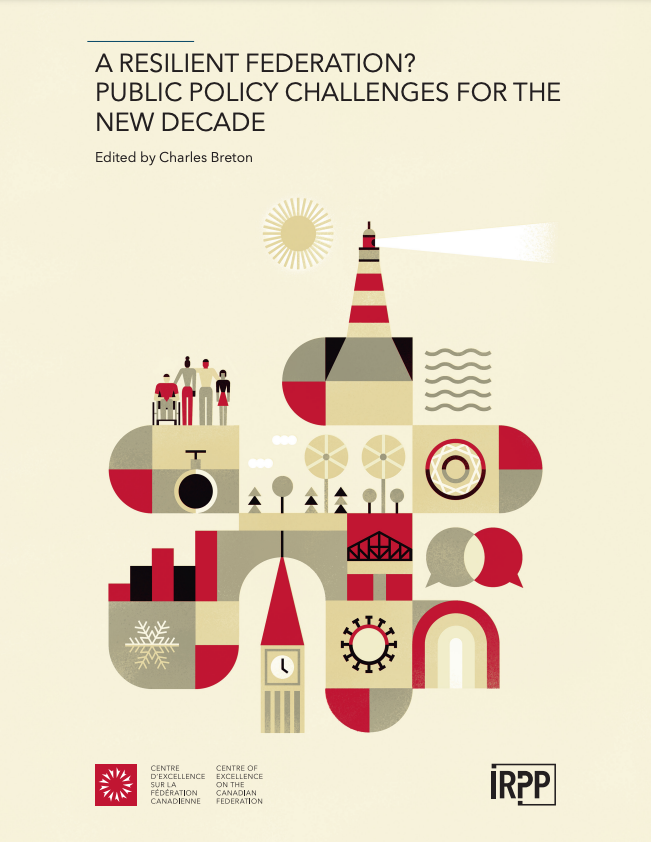Resilient Federalism and Transformative Policy Change: What are the Prospects for a New “National Policy” in Canada?
INTRODUCTION
Economic, social and institutional constraints make swift policy change difficult even in normal times. The COVID-19 pandemic, however, has created a critical juncture. Such rare historical episodes make us experience the present against the backdrop of possibilities that were, until very recently, difficult to imagine. Moreover, critical junctures are “critical” because decisions made under such conditions can have long-lasting consequences.
It is no coincidence that think tanks, academics and new leadership initiatives in Canada and around the world are seeking to seize the moment. Governments are still preoccupied with short-term emergency responses to contain a highly contagious virus and mitigate its social and economic implications. That leaves room for others to formulate innovative proposals for a postpandemic, long-term recovery.
The challenges these proposals address relate partly to the multiple risks presented by the pandemic, risks that call for effective policy solutions to support public health and long-term care. The broader, emerging debate, however, focuses on how the current window of opportunity can be used to address an array of fundamental, interrelated policy challenges such as global warming, economic inequality and the systemic marginalization of vulnerable groups. Although these policy challenges have been on the agenda for quite some time, the COVID-19 pandemic has brought them into sharper focus. We know from similar critical junctures in the past that transformative change is only possible if certain prerequisites are met. In Canada, reconstructive leadership, collaborative federalism and the development of a multipronged approach that outlines mutually enforcing policy goals and feasible instruments are of particular importance.
RESILIENT FEDERALISM
Federal systems are often praised for their resilience. Their institutional architecture appears to be better suited to cope with external challenges, especially if one compares federal systems with centralized, unitary states. This assumption, however, does not hold true when one looks at the practice of policy-making in many federations. In some systems, like Germany, federalism is often blamed for complicating the enactment of major policy projects by producing either political deadlock or decisions that favour the lowest common denominator. In others, like Canada, federalism is criticized for encouraging unpredictable, unilateral policy changes that impede the development of consistent, country-wide approaches to policy challenges.
A resilient federation should avoid both of these pathologies of federal governance. Resilience is commonly understood as the capacity of an organization to evolve dynamically in the face of shocks and stresses as well as other subtler and more gradually emerging problems. This implies sustaining and balancing continuity while promoting adaptive change. There are two challenges to the advancement of transformative policies. The first is enacting a policy change that redirects an already established pathway (such as a fossil-fuel-based economy) onto a new policy trajectory (a low carbon economy). The second is consolidating initial policy changes in an evolutionary process that shields the new pathway from potential reversals. This challenge requires ongoing changes to public policies, and procedural reforms that adjust the overarching governance structure to make transformative change sustainable. A truly resilient federation is capable of coping with both challenges.
Although the architecture of Canadian federalism promotes policy innovation at both the federal and provincial levels, it is difficult to consolidate and sustain a new policy pathway over time. The main challenge for enhancing resilience in the Canadian federation, therefore, is to develop governance capacities that accompany, monitor and reinforce paradigmatic changes at the policy level.[1]
CRITICAL JUNCTURES AND TRANSFORMATIVE CHANGE IN CANADA
Canada has witnessed the formation, consolidation and partial decay of three large-scale, paradigmatic policy regimes. The first was the National Policy, brought in after the 1878 election by the Liberal-Conservative coalition government led by Sir John A. Macdonald. Its core elements were a protective tariff, railway construction and immigration. The second regime followed the Great Depression and the Second World War and is sometimes called the Second National Policy. It entailed a commitment to advance international free trade and the construction of a Keynesian welfare state. The last major paradigmatic change took place in the early 1980s, when a more market-based regime resurfaced under the Progressive Conservative government led by Brian Mulroney. This regime was reinforced in the following decades at the provincial and federal levels.
The 1989 Canada-United States Free Trade Agreement and the 1994 North American Free Trade Agreement strengthened existing patterns of trade liberalization, albeit on a larger scale. In industrial, macroeconomic infrastructure and social policy, priorities shifted more radically toward fiscal restraint, deregulation and privatization. The Mulroney government dismantled or abolished major policy innovations introduced in the spirit of the interventionist, Keynesian, postwar order by the Liberal government led by Pierre Elliott Trudeau. The most notable changes Mulroney introduced were to the Foreign Investment Review Agency and the National Energy Program.
The financial crisis of 2007-08 did not result in paradigmatic policy changes, even though it revealed the vulnerability of the market-based regime.
The parameters of far-reaching change are different today because of the historically unprecedented drop in the price of oil; the escalating impacts of climate change, like wildfires and flooding; divestment activism; and more profitable returns from renewables. The order-shattering, global COVID-19 pandemic may become the catalyst for a new national policy.[2] But although critical junctures reduce the usual constraints on political action and could create a political dynamic conducive to far-reaching policy changes, they do not generate them on their own. To consolidate transformative policy in the long term and avoid abrupt reversals, three additional conditions are crucial in the context of Canadian federalism. They are reconstructive leadership, collaborative federalism and the development of a multipronged approach.
RECONSTRUCTIVE LEADERSHIP
Stephen Skowronek, a political scientist at Yale University, identified reconstructive leadership as one of four types of recurring leadership patterns in US politics.[3] Each leadership pattern represents a typical reaction to the condition of the inherited policy regime. “Condition” means whether the regime is stable or vulnerable. “Reaction” refers to whether the president supports or repudiates it. Reconstructive presidents, like Franklin D. Roosevelt and Ronald Reagan, took office when the established political order was widely perceived to be in crisis and both were poised to entrench a new regime.
Skowronek’s theory can be applied to the Canadian context, with some modifications,[4] to help us to understand potential future scenarios. There have been reconstructive leaders in Canada at both the provincial and federal levels. Tommy Douglas, former premier of Saskatchewan, and Jean Lesage, former premier of Quebec, enacted major policy and institutional reforms that transformed their provinces at a time when the established order was in decay. Mulroney represented the latest manifestation of reconstructive federal leadership. All his successors have worked within the confines of his historical legacy. Some leaders, like Stephen Harper, former Conservative prime minister, further entrenched the principles of the market-based regime. Others, like former Liberal prime ministers Jean Chrétien and Paul Martin, adjusted their programs to align them with a regime they had not previously championed. For example, the Third Way politics of Chrétien and Martin attempted to reconcile centre-left social policies with centre-right economic policies.
At the end of a regime cycle, when established policy goals and instruments are increasingly called into question as they no longer seem suitable to address major challenges, two leadership scenarios arise. Regime affiliates sometimes attempt to breathe new life into an old, perhaps even collapsing, order. This was exemplified by the presidency of Jimmy Carter. It can also describe Pierre Elliott Trudeau’s final years in office. He sought to re-establish credibility for an order in decay through the reinvigoration of a highly interventionist federal government. Alternatively, political leaders can adopt a reconstructive leadership style by repudiating the old and entrenching a new policy regime.
It is far from clear that Justin Trudeau is committed to reconstructive leadership. A rhetoric of transformative change, such as he espoused in 2015, is not enough. Reconstructive leadership requires a fundamentally new way of conceiving of the state and society. This was the case with the arrival of Keynesian ideas in Canada in the 1930s and 1940s, and neoliberalism in the 1980s. The nationalization of the Trans Mountain Pipeline appears reminiscent of his father’s efforts to rescue an old regime whose time had come to an end. Yet, other decisions by the current prime minister, like the Pan-Canadian Framework on Clean Growth and Climate Change, do indicate a potential for transformative change.
COLLABORATIVE FEDERALISM
Federal unilateralism is not a viable pathway to consolidate transformative change. To make initial policy innovations sustainable, it is crucial to shield them from disruptive reversals by future governments at the national or subnational level.[5] It is therefore essential to create constituencies of supporters who will help sustain a new policy regime, and to change the cognitive mindset of key stakeholders and the public. Political scientists call this “positive policy feedback.“
Earlier episodes of transformative politics demonstrate that generating positive policy feedback in a diverse federation like Canada is difficult, but not impossible. Fostering such a dynamic depends on wise policy choices that facilitate a fair transition from one regime to another. It also depends on procedural requirements. A well-functioning system of intergovernmental relations, therefore, is a second precondition to facilitate transformative policy change.
Politically motivated federal-provincial battles over carbon pricing and pipelines hide the fact that Canada’s system of intergovernmental relations has worked fairly well in recent years. As Robert Schertzer and Mireille Paquet[6] have shown, initial responses by the federal, provincial and territorial governments to complex intergovernmental problems, like housing, illegal border crossings and the COVID-19 pandemic, were surprisingly effective. This is remarkable, especially when compared with current crisis management in federations such as Germany and Switzerland, which are often praised for their strong, cooperative federalism. In Germany, conflict among Land governments, as well as between Länder and the federal government, surfaced soon after lockdown measures were enacted. It intensified in April and May 2020 over the timing and scope of reopening. This debate reached a new peak when the Land government of Thuringia announced in late May that it would unilaterally lift all restrictions. This was an almost unprecedented step in German intergovernmental relations.[7] In Switzerland, the cantons blamed the federal government for its ongoing, centralized “micromanagement” as the country slowly opened up in May.[8]
Research on Canadian intergovernmental relations indicates evidence of emerging “ties of trust”[9] and different forms of “reciprocity”[10] across policy sectors that can be further cultivated. Such norms are an important prerequisite for problem-solving rather than pure bargaining. Yet at least two major governmental stakeholders still have not been awarded an appropriate role in intergovernmental relations: Indigenous peoples and municipalities.
Since 2015, the federal government has recognized the importance of these stakeholders, and has initiated important changes. But there still exists a significant gap between its partnership rhetoric and the realities of an unchanged, top-down approach to governance. The resurgence of Indigenous protests in early 2020 revealed how far we still are from implementing a functioning, nation-to-nation approach in intergovernmental relations. In a similar vein, the Federation of Canadian Municipalities lacks a formalized role in intergovernmental relations that would allow cities to engage in policy-making, as do Australia and the European Union. As a consequence, new policy initiatives are not coherently integrated, and they are not driven by the specific needs of urban areas.[11]
A MULTIPRONGED APPROACH
Bob Rae, former Ontario premier, wrote recently that “the federal government established the Rowell-Sirois Commission many decades ago to deal with the impacts of the Great Depression. We can rest assured that something like it will be needed once again.”[12] Indeed, the 1938 National Employment Commission and the 1940 Rowell-Sirois Commission provided important expertise that facilitated the transition toward a Keynesian welfare state in Canada. Similarly, the 1984 Macdonald Commission paved the way for a market-based regime in the late 1980s and 1990s.
To be successful, transformative policy change requires the development of a multi-pronged approach that outlines policy goals and feasible instruments that mutually reinforce each other. This is a major challenge for politics and society, for political and practical reasons. Transformative policy change is inevitably conflict-laden and fraught with uncertainties. It redistributes power resources between persons and places and has uneven effects on the various economic sectors. Moreover, the weight of an increasingly differentiated, complex array of policy legacies is heavier today than during earlier episodes of transformative change.
A commission of inquiry, with a broad mandate, representing the diverse interests of Canadian society, could provide policy guidance, legitimacy and momentum. Research offers important advice for policy-makers and helps stimulate the broader public discourse. Importantly, such a commission could craft an integrated approach. As with past transitions, this would include policy innovations that build industry, infrastructure and society, and promote an effective and legitimate transition to a new policy regime.[13] Industry-building policies flow from revaluating economic activities in terms of how they generate negative or positive effects on the environment and society. They should include viable ways in which the state can encourage economic behaviour that contributes to more sustainable and resilient communities across the country. Infrastructure-building policies complement this transition. They help promote change in areas like transportation, communication or banking, to develop the technical and financial foundations for organizing economic and social interactions in what will be the postpandemic new normal. Finally, society-building policies compensate for the redistributive consequences of transformative policy, facilitating a fair and inclusive transition toward a new policy regime.
CONCLUSION
Canadian federalism concentrates power in the hand of provincial and federal executives, while institutional checks and balances are comparatively weak. This enables governments to introduce major policy change more easily than in most federations. However, it can also become an obstacle for the formulation and implementation of broad, coherent programs over time. Canada has successfully addressed these challenges in the past, through a combination of reconstructive leadership, intergovernmental collaboration and a commission of inquiry with a broad mandate. This facilitated the transition to a new regime.
Sustaining a broad, new policy trajectory is, therefore, not impossible. At this critical juncture, with an increasingly vulnerable market-based regime still in place, centre-left politicians hold most of the cards. It is crucial, however, to anticipate potential setbacks and to mobilize the governance capacities required to navigate the complexities of reform in the long term. By definition, critical junctures are relatively short periods in time, but the window opened by the COVID-19 pandemic will not close within weeks or even months. Nevertheless, decision-makers need to act quickly as they refocus their activities from emergency management to planning long-term recovery. It will be important to launch this process well before the window closes.
[1] By paradigmatic change, I mean a deep and encompassing shift in the way we conceive of and address major challenges across different policy sectors.
[2] I use the notion of a “national policy” in lieu of a better label, being fully aware that this notion is problematic in a multinational federation.
[3] The other types are “disjunctive,” “articulative” and “preemptive.” See S. Skowronek, The Politics Presidents Make: Leadership from John Adams to Bill Clinton (Cambridge, MA: Harvard University Press, 1997).
[4] J. Broschek, “The Politics Prime Ministers Make: Secular and Political Time in Canadian Context,” Canadian Political Science Review 12, no. 1 (2018): 1-23.
[5] E. Patashnik, Reforms at Risk: What Happens after Major Policy Changes Are Enacted (Princeton: Princeton University Press, 2006).
[6] R. Schertzer and M. Paquet, “How Well Is Canada’s Intergovernmental System Handling the Crisis?” Policy Options, April 8 (Montreal: Institute for Research on Public Policy, 2020).
[7] “Thuringia: Germany’s Coronavirus Guinea Pigs?” Deutsche Welle News, May 25, 2020.
[8] “Der Kampf gegen das Virus geht in die nächste Phase – schlägt jetzt die Stunde der Kantone?“ Neue Züricher Zeitung, May 14, 2020.
[9] C. J. Kukucha, Provincial/Territorial Governments and the Negotiation of International Trade Agreements. IRPP Insight 10 (Montreal: Institute for Research on Public Policy, 2016).
[10] R. Schertzer, A. McDougall, and G. Skogstad, Collaboration and Unilateral Action: Recent Intergovernmental Relations in Canada. IRPP Study 62 (Montreal: Institute for Research on Public Policy, 2016).
[11] N. Bradford, A National Urban Policy for Canada? The Implicit Federal Agenda. IRPP Insight 24 (Montreal: Institute for Research on Public Policy, 2018).
[12] B. Rae, “Federalism and the COVID-19 Crisis: The View from Canada” (Ottawa: Forum of Federations, 2020), 2, https://www.forumfed.org/wp-content/uploads/2020/04/Bob_RAE_CanadaCOVID.pdf
[13] L. Eden and M. A. Molot, “Canada’s National Policies: Reflections on 125 Years,” Canadian Public Policy 19, no. 3 (1993): 232-51.
This essay was published as part of the inaugural essay series for the Centre of Excellence on the Canadian Federation, under the direction of Charles Breton. The manuscript was reviewed by F. Leslie Seidle and copy-edited by Madelaine Drohan, proofreading was done by Zofia Laubitz, editorial coordination by Francesca Worrall, production and layout by Chantal Létourneau and Anne Tremblay.
A french translation of this text is available under the title:
Fédéralisme résilient et politiques renouvelées : une nouvelle « politique nationale » pour le Canada ?
Jörg Broschek is Canada Research Chair (Tier 2) in Comparative Federalism and Multi- level Governance and associate professor at Wilfrid Laurier University. His research focuses on the long-term effects of institutional reforms in federal systems, as well as trade policy and federalism. He has been principal investigator and co-applicant on Connection, Insight and Partnership Development Grants from the Social Sciences and Humanities Research Council of Canada (SSHRC). His most recent publication is a volume coedited with Patricia Goff, The Multilevel Politics of Trade (University of Toronto Press, 2020).
To cite this document:
Broschek, Jörg. 2020. Resilient Federalism and Transformative Policy Change: Prospects for a New “National Policy” in Canada, Essay no. 1, Montreal, Institute for Research on Public Policy.











